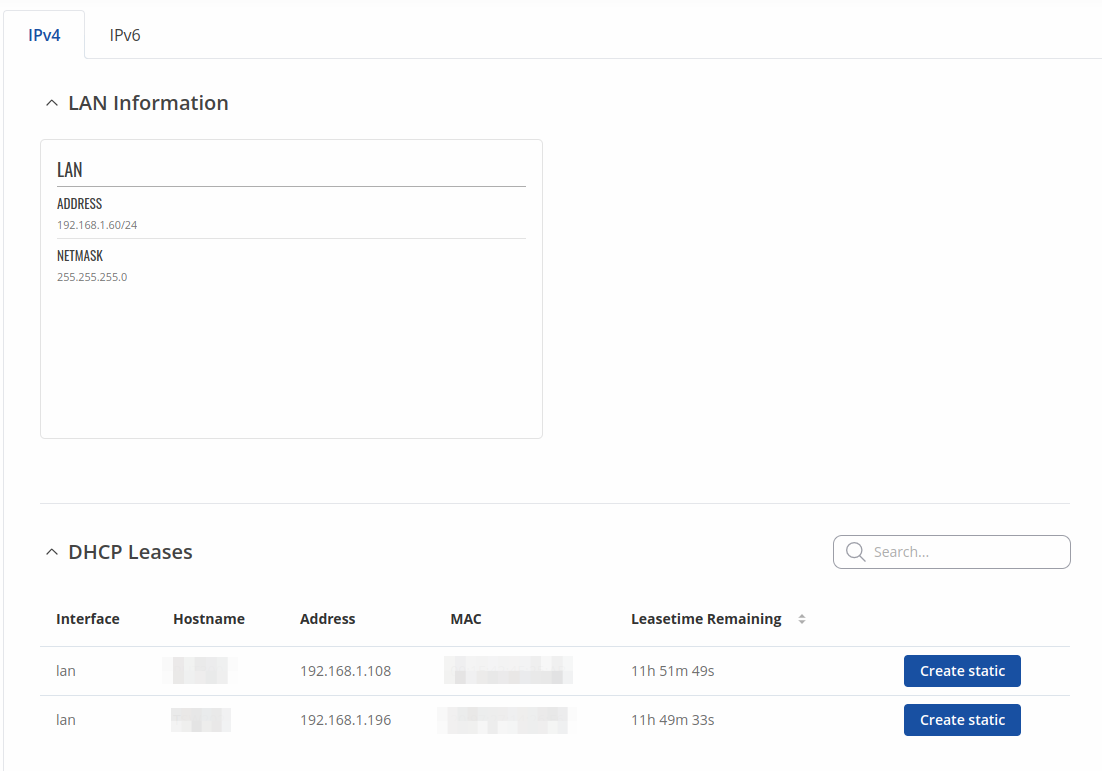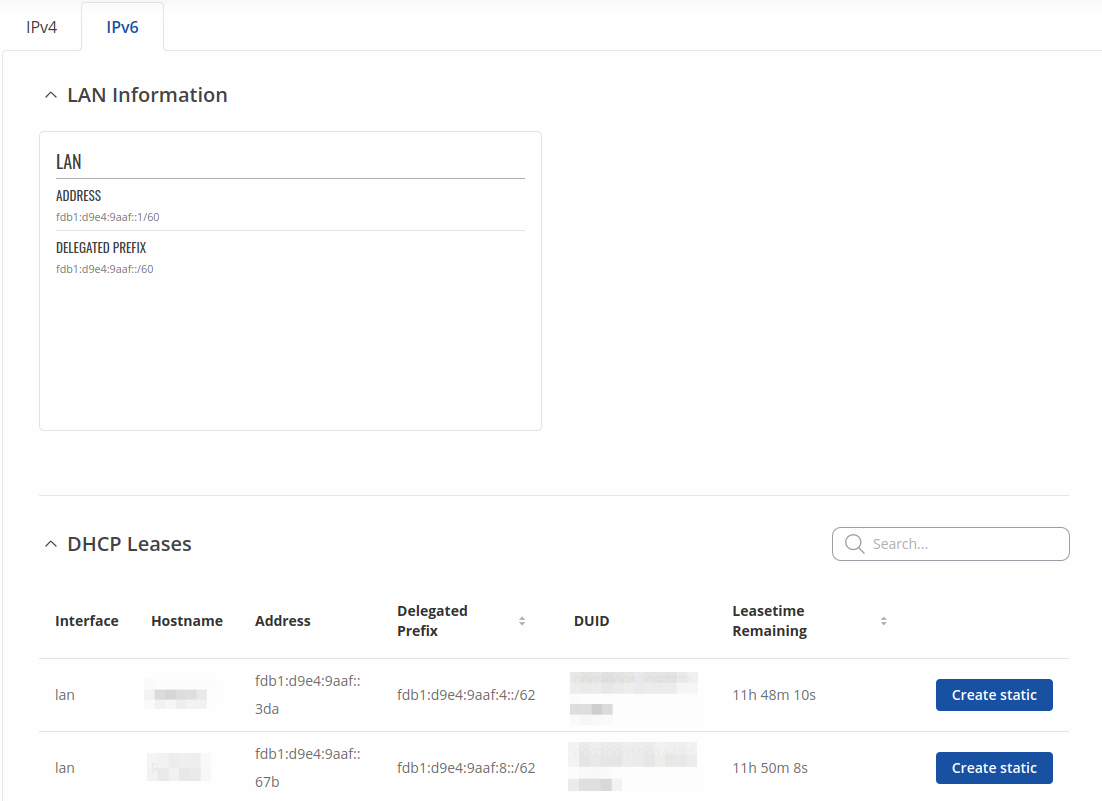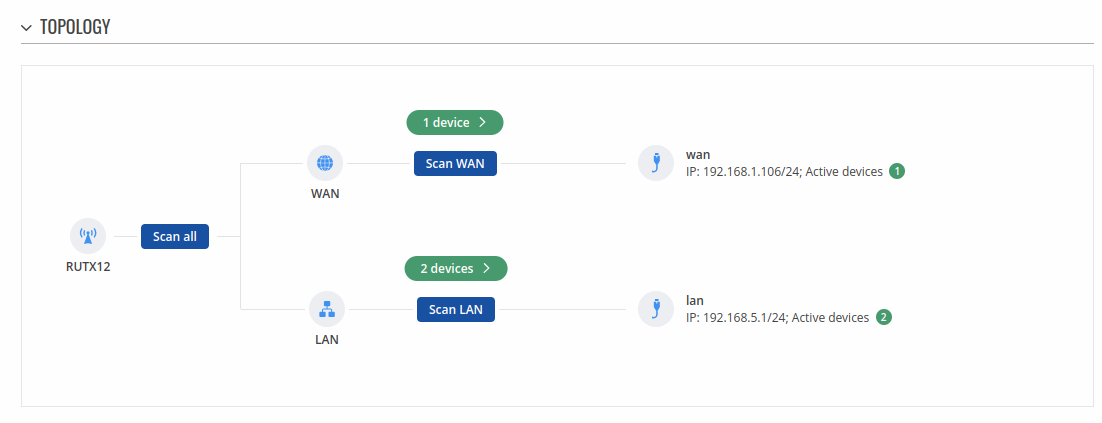Difference between revisions of "Template:Networking rutos manual network"
| (7 intermediate revisions by 3 users not shown) | |||
| Line 25: | Line 25: | ||
| RUTX | RUTM = | | RUTX | RUTM = | ||
{{#switch: {{{name}}} | {{#switch: {{{name}}} | ||
| − | | RUTX09|RUTX11|RUTXR1|RUTX50|RUTM09|RUTM11|RUTM50|RUTX14 = [[File:Networking rutx manual network mobile | + | | RUTX09|RUTX11|RUTXR1|RUTX50|RUTM09|RUTM11|RUTM50|RUTX14 = [[File:Networking rutx manual network mobile v6.png|border|class=tlt-border]] |
| − | | RUTX12|RUTM12 = [[File:Networking rutx12 manual network mobile | + | | RUTX12|RUTM12 = [[File:Networking rutx12 manual network mobile v6.png|border|class=tlt-border]] |
}} | }} | ||
| − | | TRB1|RUT2|RUT2M|RUT36X|TRB5 = [[File: | + | | TRB1|RUT2|RUT2M|RUT36X|TRB5|RUT361|TCR1 = [[File:Networking_trb14x_manual_network_v6.png|border|class=tlt-border]] |
| − | | TRB2|RUT9|RUT9M | + | | TRB2|RUT9|RUT9M|TRB2M|OTD140 = [[File:Networking_trb2XX_manual_network_v6.png|border|class=tlt-border]] |
| − | |||
}} | }} | ||
| Line 107: | Line 106: | ||
</tr> | </tr> | ||
<tr> | <tr> | ||
| − | <td> | + | <td>Connection stage</td> |
<td>Show intermediate stages of mobile connection establishing process.</td> | <td>Show intermediate stages of mobile connection establishing process.</td> | ||
</tr> | </tr> | ||
| Line 116: | Line 115: | ||
<li> <b>5G</b>: 5G (NSA), 5G (SA)</li>|}} | <li> <b>5G</b>: 5G (NSA), 5G (SA)</li>|}} | ||
<li> <b>4G</b>: | <li> <b>4G</b>: | ||
| − | {{# | + | {{#switch: {{{name}}} | TRB255 | TRB256 = |
4G (NB), 4G (M1) | 4G (NB), 4G (M1) | ||
| − | | 4G (LTE) }} | + | | #default = 4G (LTE) }} |
</li> | </li> | ||
| − | {{# | + | {{#switch: {{{name}}} | TRB255 | TRB256 = | #default= |
<li> <b>3G</b>: 3G (WCDMA), 3G (HSDPA), 3G (HSUPA), 3G (HSPA), 3G (HSPA+), 3G (DC-HSPA+), 3G (HSDPA+HSUPA), UMTS</li> | <li> <b>3G</b>: 3G (WCDMA), 3G (HSDPA), 3G (HSUPA), 3G (HSPA), 3G (HSPA+), 3G (DC-HSPA+), 3G (HSDPA+HSUPA), UMTS</li> | ||
}} | }} | ||
| − | {{#ifeq: {{{ | + | {{#ifeq: {{{2g}}} | 1 | <!-- add variable for rut9 devices --> |
<li><b>2G</b>: 2G (GSM), 2G (GPRS), 2G (EDGE)</li> | <li><b>2G</b>: 2G (GSM), 2G (GPRS), 2G (EDGE)</li> | ||
}} | }} | ||
| Line 137: | Line 136: | ||
By combining more than one carrier together, either in the same or different bands it is possible to increase the bandwidth available and in this way increase the capacity of the link. | By combining more than one carrier together, either in the same or different bands it is possible to increase the bandwidth available and in this way increase the capacity of the link. | ||
</td> | </td> | ||
| − | + | </tr> | |
| − | + | <tr> | |
| + | <td>Bandwidth</td> | ||
| + | <td>Bandwidth describes the maximum data transfer rate of Internet connection.</td> | ||
| + | </tr> | ||
| + | <tr> | ||
<td>Connected band</td> | <td>Connected band</td> | ||
<td>Currently used mobile frequency band.</td> | <td>Currently used mobile frequency band.</td> | ||
</tr> | </tr> | ||
<tr> | <tr> | ||
| − | <td> | + | <td>RSSI</td> |
<td>Received signal strength indicator (<b>[[RSSI]]</b>) measured in dBm. Values closer to 0 indicate a better signal strength</td> | <td>Received signal strength indicator (<b>[[RSSI]]</b>) measured in dBm. Values closer to 0 indicate a better signal strength</td> | ||
</tr> | </tr> | ||
<tr> | <tr> | ||
| − | <td> | + | <td>Data received</td> |
<td>Amount of data received through the mobile interface</td> | <td>Amount of data received through the mobile interface</td> | ||
</tr> | </tr> | ||
<tr> | <tr> | ||
| − | <td> | + | <td>Data sent</td> |
<td>Amount of data sent through the mobile interface</td> | <td>Amount of data sent through the mobile interface</td> | ||
</tr> | </tr> | ||
| Line 159: | Line 162: | ||
</tr> | </tr> | ||
<tr> | <tr> | ||
| − | <td>LAC</td> | + | <td>LAC/TAC</td> |
| − | <td>The Location Area Code, abbreviated as LAC is the unique number given to each location area within the network. The served area of a cellular radio access network is usually divided into location areas, consisting of one or several radio cells.</td> | + | <td><li><b>LAC</b> The Location Area Code, abbreviated as LAC is the unique number given to each location area within the network. The served area of a cellular radio access network is usually divided into location areas, consisting of one or several radio cells GSM/3G</li><li><b>TAC</b> Tracking Area Code is a numerical identifier used in LTE networks to distinguish different tracking areas. A tracking area is a group of cells that share the same identity for tracking and paging purposes. TAC is an essential parameter for the UE to determine its location within the LTE/5G network.</li></td> |
</tr> | </tr> | ||
<tr> | <tr> | ||
| Line 168: | Line 171: | ||
<tr> | <tr> | ||
<td>EARFCN</td> | <td>EARFCN</td> | ||
| − | <td>In | + | <td>In mobile cellular networks, an absolute radio-frequency channel number (ARFCN) is a code that specifies a pair of physical radio carriers used for transmission and reception in a land mobile radio system, one for the uplink signal and one for the downlink signal.</td> |
</tr> | </tr> | ||
<tr> | <tr> | ||
| Line 179: | Line 182: | ||
</tr> | </tr> | ||
</table> | </table> | ||
| − | |||
| − | |||
| − | + | If mobile data limit is set and reached, near ''Connection'' column warning mark will appear. E.g.: | |
| − | + | ||
| − | + | [[File:Networking rutos manual network mobile data limit.png|border|class=tlt-border]] | |
| − | |||
| − | |||
| − | |||
| − | |||
====Bands==== | ====Bands==== | ||
| + | |||
<br /> | <br /> | ||
<table class="nd-othertables"> | <table class="nd-othertables"> | ||
| Line 213: | Line 211: | ||
</li> | </li> | ||
| − | {{# | + | {{#switch: {{{name}}} | TRB255 | TRB256 = | #default = |
<li><b>3G</b> | <li><b>3G</b> | ||
<ul> | <ul> | ||
| Line 222: | Line 220: | ||
}} | }} | ||
| − | {{#ifeq: {{{ | + | {{#ifeq: {{{2g}}} | 1 | |
<li><b>2G</b> | <li><b>2G</b> | ||
<ul> | <ul> | ||
| Line 240: | Line 238: | ||
This tab displays information about the device's local network(s). The figure below is an example of the '''Network''' window: | This tab displays information about the device's local network(s). The figure below is an example of the '''Network''' window: | ||
| − | + | [[File:Networking rutos manual network lan ipv4 v1.png|border|class=tlt-border]] | |
<table class="nd-othertables"> | <table class="nd-othertables"> | ||
| Line 251: | Line 249: | ||
</tr> | </tr> | ||
<tr> | <tr> | ||
| − | <td> | + | <td>Address</td> |
<td>IP address of the LAN interface</td> | <td>IP address of the LAN interface</td> | ||
</tr> | </tr> | ||
| Line 260: | Line 258: | ||
<tr> | <tr> | ||
<th colspan="2">dhcp leases</th> | <th colspan="2">dhcp leases</th> | ||
| + | </tr> | ||
| + | <tr> | ||
| + | <td>Interface</td> | ||
| + | <td>Interface which leased the address</td> | ||
</tr> | </tr> | ||
<tr> | <tr> | ||
| Line 277: | Line 279: | ||
<td>Remaining lease time for a DHCP client. Active DHCP lease holders will try to renew their DHCP leases after a half of the lease time passes. </td> | <td>Remaining lease time for a DHCP client. Active DHCP lease holders will try to renew their DHCP leases after a half of the lease time passes. </td> | ||
</tr> | </tr> | ||
| − | + | <tr> | |
<td>Static Lease</td> | <td>Static Lease</td> | ||
<td>This action will reserve currently assigned IP address for the device in Network -> Interfaces -> Static leases. </td> | <td>This action will reserve currently assigned IP address for the device in Network -> Interfaces -> Static leases. </td> | ||
| − | </tr> | + | </tr> |
| + | </table> | ||
| + | |||
| + | Similarly there is an IPv6 dedicated tab. | ||
| + | |||
| + | [[File:Networking rutos manual network lan ipv6 v1.png|border|class=tlt-border]] | ||
| + | |||
| + | <table class="nd-othertables"> | ||
| + | <tr> | ||
| + | <th colspan="2">lan information</th> | ||
| + | </tr> | ||
| + | <tr> | ||
| + | <td width="250">Name</td> | ||
| + | <td width="900">LAN interface name</td> | ||
| + | </tr> | ||
| + | <tr> | ||
| + | <td>Address</td> | ||
| + | <td>IP address of the LAN interface</td> | ||
| + | </tr> | ||
| + | <tr> | ||
| + | <td>Delegated prefix</td> | ||
| + | <td>The delegated prefix is a smaller subnet given to a device to lease IPv6 addresses for its own DHCPv6 clients.</td> | ||
| + | </tr> | ||
| + | <tr> | ||
| + | <th colspan="2">dhcp leases</th> | ||
| + | </tr> | ||
| + | <tr> | ||
| + | <td>Interface</td> | ||
| + | <td>Interface which leased the address</td> | ||
| + | </tr> | ||
| + | <tr> | ||
| + | <td>Hostname</td> | ||
| + | <td>Hostname of a LAN client</td> | ||
| + | </tr> | ||
| + | <tr> | ||
| + | <td>Address</td> | ||
| + | <td>IP address of a LAN client</td> | ||
| + | </tr> | ||
| + | <tr> | ||
| + | <td>Delegated prefix</td> | ||
| + | <td>The delegated prefix is a smaller subnet given to a device to lease IPv6 addresses for its own DHCPv6 clients.</td> | ||
| + | </tr> | ||
| + | <tr> | ||
| + | <td>DUID</td> | ||
| + | <td>DHCP unique identifier is used by DHCPv6 to identify device. Similar to MAC that is used by DHCPv4. </td> | ||
| + | </tr> | ||
| + | <tr> | ||
| + | <td>Leasetime Remaining</td> | ||
| + | <td>Remaining lease time for a DHCP client. Active DHCP lease holders will try to renew their DHCP leases after a half of the lease time passes. </td> | ||
| + | </tr> | ||
| + | <tr> | ||
| + | <td>Static Lease</td> | ||
| + | <td>This action will reserve currently assigned IP address for the device in Network -> Interfaces -> Static leases. </td> | ||
| + | </tr> | ||
</table> | </table> | ||
| Line 382: | Line 437: | ||
</tr> | </tr> | ||
</table> | </table> | ||
| − | |||
| − | |||
| − | |||
| − | |||
| − | |||
| − | |||
| − | |||
| − | |||
| − | |||
| − | |||
| − | |||
| − | |||
| − | |||
| − | |||
| − | |||
| − | |||
| − | |||
| − | |||
| − | |||
| − | |||
| − | |||
| − | |||
| − | |||
| − | |||
| − | |||
| − | |||
| − | |||
| − | |||
| − | |||
| − | |||
| − | |||
| − | |||
| − | |||
| − | |||
| − | |||
| − | |||
| − | |||
| − | |||
| − | |||
| − | |||
| − | |||
| − | |||
| − | |||
| − | |||
| − | |||
| − | |||
| − | |||
| − | |||
| − | |||
| − | |||
| − | |||
| − | |||
| − | |||
| − | |||
| − | |||
| − | |||
| − | |||
| − | |||
| − | |||
| − | |||
| − | |||
| − | |||
| − | |||
| − | |||
| − | |||
| − | |||
| − | |||
| − | |||
==Topology== | ==Topology== | ||
Latest revision as of 16:12, 15 April 2024
The information in this page is updated in accordance with firmware version .
Summary
The Network page contains information related to the device's networking. This chapter is an overview of the Network page in {{{name}}} devices.
If you're having trouble finding this page or some of the parameters described here on your device's WebUI, you should turn on "Advanced WebUI" mode. You can do that by clicking the "Advanced" button, located at the top of the WebUI.
LAN
This tab displays information about the device's local network(s). The figure below is an example of the Network window:
| lan information | |
|---|---|
| Name | LAN interface name |
| Address | IP address of the LAN interface |
| Netmask | Netmask of the LAN interface. In a sense, a netmask specifies the size of a network. In other words, it indicates which part of the IP address denotes the network, and which denotes the device |
| dhcp leases | |
| Interface | Interface which leased the address |
| Hostname | Hostname of a LAN client |
| IP Address | IP address of a LAN client |
| MAC Address | MAC address of a LAN client |
| Leasetime Remaining | Remaining lease time for a DHCP client. Active DHCP lease holders will try to renew their DHCP leases after a half of the lease time passes. |
| Static Lease | This action will reserve currently assigned IP address for the device in Network -> Interfaces -> Static leases. |
Similarly there is an IPv6 dedicated tab.
| lan information | |
|---|---|
| Name | LAN interface name |
| Address | IP address of the LAN interface |
| Delegated prefix | The delegated prefix is a smaller subnet given to a device to lease IPv6 addresses for its own DHCPv6 clients. |
| dhcp leases | |
| Interface | Interface which leased the address |
| Hostname | Hostname of a LAN client |
| Address | IP address of a LAN client |
| Delegated prefix | The delegated prefix is a smaller subnet given to a device to lease IPv6 addresses for its own DHCPv6 clients. |
| DUID | DHCP unique identifier is used by DHCPv6 to identify device. Similar to MAC that is used by DHCPv4. |
| Leasetime Remaining | Remaining lease time for a DHCP client. Active DHCP lease holders will try to renew their DHCP leases after a half of the lease time passes. |
| Static Lease | This action will reserve currently assigned IP address for the device in Network -> Interfaces -> Static leases. |
Firewall
This tab displays information about the device's firewall. Info is shown of IPv4 and IPv6 traffic. The figure below is an example of the Firewall page tables:
| Field name | Description |
|---|---|
| Reset counters | Resets all traffic and packet fields |
| Name | Name of the chain |
| Traffic | Size of traffic that was matched to the chain |
| Packets | Count of packets that were matched to the chain |
| Policy | Policy for traffic entering the zone. |
| Rules | Count of rules the chain has |
| References | Count of times the chain was referenced in other chains |
For more information about specific firewall chain, INFO button can be pressed. Window like this should pop up:
| Field name | Description |
|---|---|
| Traffic | Size of traffic that was matched to the rule |
| Packets | Count of packets that were matched to the rule |
| Target | Name of the rule (if highlighted you can click it to open modal to it) |
| Protocol | Filters by Internet protocol |
| In | Filters by inbound interface |
| Out | Filters by outbound interface |
| Source | Filters by source address |
| Destination | Filters by destination address |
| Options | Additional iptables options |
| Comment | Filters by comment |
Topology
The Topology tab allows scanning of WAN, LAN or both interfaces via arp scan to check active connected devices. After scan it shows how many active devices were found and on which interface.
All active devices
This section displays the results of the scan.
| field name | description |
|---|---|
| Hostname (Vendor) | Hostname of scanned device |
| IP Address | IP address of scanned device |
| MAC Address | MAC address of scanned device |
| Type | The type of connection |
| Interface | The interface the scanned device is connected |
[[Category:{{{name}}} Status section]]









